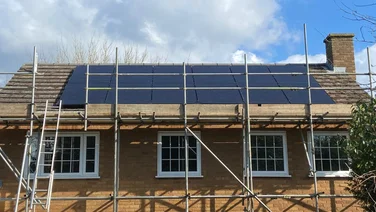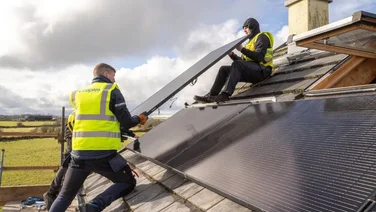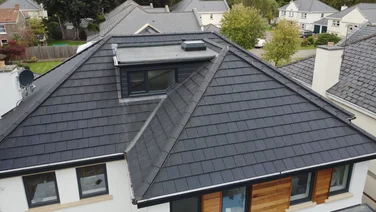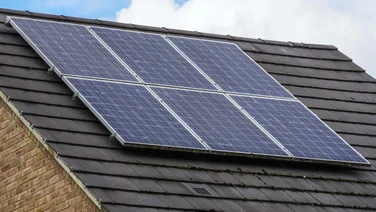- China dominates with a total solar capacity of 2,919GW
- 10 countries control 74% of the global PV market
- The UK is held back by high rates of planning permission refusals

Solar power is gradually taking over the energy industry, with global solar capacity growing to about one and a half terawatts (TW) at the end of 2023. Part of this growth is undoubtedly due to solar panel costs dropping by 82% since 2010.
By 2025, solar capacity worldwide is expected to reach around 2.3TW—some way off the 432TW needed to provide all of Earth’s electricity needs, but progress nonetheless.
Most of the current capacity isn’t from residential solar panels but from commercial solar farms. With more incentives, lower costs, and better technology, solar farms are spreading across the world.
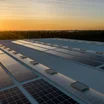
Get free solar panels quotes
Answer a few quick questions, and our trusted installers will send you bespoke solar panel quotes – for free.
The world’s largest solar farms
We’ve looked at the 15 biggest solar farms in the world right now, examining capacity, total investment, and the future of solar power worldwide.
We’ve used the most accurate and up-to-date information we could find, from a combination of official websites (where available), the NS Energy Business solar project database, and other sources like NASA.
1. Xinjiang solar farm — China
The Xinjiang solar farm in China has just become the world’s largest solar farm, with an installed solar capacity of 5GW.
Officially connected to the grid on Monday the 3rd of June, 2024, this enormous solar power plant dwarfs all others on this list.
The power plant is able to produce so much power that it could, in theory, power the entirety of Luxembourg or Papua New Guinea for an entire year.
2. Golmud Solar Park — China
The Golmud Solar Park in China is now the world’s second largest solar farm, with an installed solar capacity of 2.8 GW, putting it just above the second entry in our list.
It’s a hugely impressive site with nearly seven million solar panels working to deliver clean energy. China also has big ambitions for the Golmud Solar Park—it hopes to reach 16 GW within the next five to six years.
In context, a single gigawatt could power one million UK homes for an hour, or around 100 million LED light bulbs.
3. Bhadla Solar Park — India

Bhadla solar park in India as seen from space – credit Sentinel Hub
Bhadla, the second largest solar farm in the world, has a capacity of 2.7GW. The site covers 14,000 acres, or 56 km2—equivalent to 3% of the entire surface area of London or just under the size of Manhattan (59.1 km2).
This area is likely the size of the entire site, rather than just that dedicated to the solar panel installation.
It also benefits from near-perfect conditions, with the Rajasthan region getting 7.57kWh per m² per day of solar irradiation on average—300 sunny days per year is perfect for a solar farm.
Moreover, the area gets just twelve inches of rain per year, making it almost uninhabitable for people but ideal for soaking up sunshine.
Like some of the other large solar farms on this list, Bhadla was commissioned by multiple corporations auctioning offset amounts of solar capacity.
For example, the Solar Energy Corporation of India auctioned off 250MW capacity, and 27 companies submitted bids.

Get free solar panels quotes
Answer a few quick questions, and our trusted installers will send you bespoke solar panel quotes – for free.
4. Mohammed bin Rashid Al Maktoum Solar Park — UAE

Aerial view of Mohammed bin Rashid Al Maktoum Solar Park 2020 – credit Sentinel Hub
Ordinarily known for its vast oil reserves, the United Arab Emirates’ also boasts the third biggest solar farm in the world. The Mohammed bin Rashid Al Maktoum Solar Park (MBR) sits in designated areas 52,881 acres (214km2) in size, putting the UAE firmly in the spotlight.
Despite being bigger than the second and third-largest solar farms, MBR hasn’t yet reached the same power output. MBR plans to expand its current capacity of 2.62GW to around 5GW by 2030, possibly earlier.
It already provides power to 270,000 homes and offsets roughly 1.4 million tonnes of CO2 emissions yearly. That’s good, but with the UAE having one of the highest emissions per capita globally, much more remains to be done.
It is also the most expensive solar farm on this list by some margin. An estimated $13.6 billion has been invested throughout its multi-phase construction.
5. Pavagada Solar Park — India

Aerial view of Pavagada Solar Park – credit Sentinel Hub
India’s Pavagada Solar Park sits in 5th place. At 13,000 acres (53km2), it’s still an extraordinary scale compared to many of the solar farms in this list.
Pavagada has a 2.05GW capacity, another exciting slice of the country’s developing renewable energy plans. Costing $2 billion, the solar farm makes up a good chunk of the $20 billion (Rs 16.93 Lakh Crore) India has spent on developing renewable energy up to 2024.
6. Benban Solar Park — Egypt
Benban Solar Park in Egypt is Africa’s largest solar farm and the sixth largest in the world. It has a colossal solar potential of 6.3 kWh per m2 per day.
Benban cost $4 billion to build and has a capacity of 1.8GW, providing power to hundreds of thousands of Egyptian homes.
It’s part of the country’s Nubian Suns Feed-In Tariff programme, which aims to encourage more businesses to invest in renewable energy initiatives.
7. The Tengger Desert Solar Park — China
China’s solar ambitions are clear, with another huge solar farm making its way onto this list.
The Tengger Desert Solar Park’s 10,626 acres (43 km2) of solar panels, have a combined capacity of 1.5GW and currently power around 600,000 homes.
8. Noor Abu Dhabi Solar Power Project — Abu Dhabi

Noor Abu Dhabi Solar Power Project – Credit Sentinel Hub
The Noor Abu Dhabi Solar Power Project might not be the most powerful at 1.2 GW or cover the largest surface area at 1,977 acres (8 km2), but it is the world’s biggest single-site solar farm.
That means it covers the widest expanse of land with unbroken solar panel arrays, which provide power to roughly 90,000 homes.
What’s significant about this solar farm is the army of robots they use to clean the solar panels. The 1.430 waterless robots travel 497 miles (800 km) daily, removing dust and other debris from the installation.
They’re designed to clean panels without using water to save what is a precious resource in this desert region.

Get free solar panels quotes
Answer a few quick questions, and our trusted installers will send you bespoke solar panel quotes – for free.
9. Datong Solar Power Top Runner Base — China

Datong Solar Power Top Runner Base, China – credit Sentinel Hub
The Datong solar farm in Shanxi is interesting because, once finished, it will have a capacity of over 3GW, making it one of the biggest solar farms in the world. However, current information for the site puts it at a total capacity of around 1.1GW.
Owners Panda Green Energy used dark monocrystalline silicon and lighter thin film cells to stagger the solar panels in an array that mimics the colouring and shape of giant pandas.
There is controversy surrounding the farm, however, with rumours of forced Uygur labour being used in its construction — an accusation that isn’t unique that isn’t unique to this solar farm.
10. Jinchuan Solar Park — China
Like many of their other solar farms, Jinchuan Solar Park can be found in China’s northern region.
Abundant sunshine and a semi-arid environment make it well suited for soaking up plenty of solar energy — a 1.03 GW output capacity that can power thousands of nearby homes.
11. Kurnool Ultra Mega Solar Park — India

Kurnool Ultra Mega Solar Park, India – Credit Sentinel Hub
This 1 GW-capacity solar farm in India’s Kurnool district can power almost the entire area during peak sunshine hours.
That’s roughly 8 GWh when there’s little to no cloud cover, a common occurrence in a region that sees just 35–40 rainy days yearly.
12. Yanchi Ningxia Solar Park — China

Yanchi Ningxia Solar Park, China – Credit Sentinel Hub
Yanchi Ningxia Solar Park in China has an impressive array of 2.5 million solar panels with a capacity of 1GW for cities nearby.
The solar park also doubles as a goji berry farm, which has helped turn a once-barren desert into a thriving oasis that benefits the local communities.
Goji berries are planted under and around the solar panels and harvested annually.
13. Villanueva Plant — Mexico
The 754MW Villanueva Plant is the largest in the Americas, costing $650 million and capable of powering almost 1.2 million homes in Mexico.
Its horizontal single-axle design means it takes up less space than is typical for solar farms. Over a year, the Villanueva Plant can generate around 1.7TWh.
14. Kamuthi Solar Power Station — India

Kamuthi Solar Power Station, India – Credit Sentinel Hub
The Kamuthi Solar Power Station is another entry for India, which combined has the fifth largest solar capacity of any country in the world.
This solar farm has a capacity of 648 MW and generates electricity for approximately 265,000 homes in the Tamil Nadu state.

Get free solar panels quotes
Answer a few quick questions, and our trusted installers will send you bespoke solar panel quotes – for free.
15. Francisco Pizarro — Spain
Europe just reached the top 15 with the Francisco Pizarro Solar Plant in Spain, a 590MW solar farm capable of powering around 334,400 homes.
That’s equivalent to removing 245,000 tonnes of CO2 annually from the atmosphere. Interestingly, extensive archaeological remains dating back to ancient and medieval times were found during the solar farm’s construction.
All steps were taken to ensure their protection and responsible excavation.
The best countries for solar power: how does your region compare?
With five solar farms in the top 15, China is currently dominating large scale solar.
Even looking at the residential scale, combined with solar farms, brings the country’s total solar capacity to 2,919GW.
That’s around 37% of all installed solar power in the world, putting the country much further ahead than the US in second place, who manage a comparatively small 12.3 % of the world’s solar power capacity.
India, despite having the second-most solar farms in the top 15, comes in fifth place for installed solar capacity. This is due to having far fewer solar panels at a residential level.
Take a look at our guide to solar panel statistics.
Here’s how most countries stack up according to Our World in Data.
The future of solar farms
Solar farms will continue to play a huge part in making clean energy more widely available, especially for people who might not be able to install their own solar panel systems.
They also represent an essential tool in the planet’s fight against the climate crisis because of their huge potential to drastically reduce emissions.
Alternative types of solar farms, such as floating solar farms or agrivoltaic farms, might also become more common in the coming years.
Here’s how the future of solar is shaping up around the world:
The future of solar in the UK
The United Kingdom has made no secret of wanting to hit net-zero emissions by 2050, and solar will be at the forefront.
Solar farms already make up part of the UK’s renewable landscape, even though there’s far less land to work with than in many other countries.
Shotwick Solar Park is currently the biggest, with a capacity of 72.2MW — enough to power some 14,000 households and offset 24,000 tonnes of CO2 annually. Other large projects include the 69.8MW Lynham solar farm and 51.9MW Owl’s Hatch solar park.
More projects are in the pipeline, too, including one from Cleve Hill Solar, which has started building what will be the largest solar farm in the UK.
Cleve Hill Solar Park will be eight times larger than Hyde Park and have around 800,000 solar panels — a leap from Shotwick’s 270,000 panels.
Longfield Solar Farm in Essex is another proposal, but it’s certainly not without its critics, who argue that the loss of good farmland isn’t worth the benefits of clean, solar-powered electricity.
One stumbling block for solar in the UK is planning permission refusals, which are currently at their highest rate for five years.
A balance needs to be struck between developing solar farms, preserving wild areas, and using the country’s extensive brownfield land — right now, ground-based solar covers just 0.1% of UK land, according to a report from Carbon Brief.
To compare, golf courses take up twice as much land as solar panels. It’s still encouraging to see the popularity of solar panels in the UK continue to increase.
In fact, according to our latest National Home Energy Survey, 69% of Brits said they would buy a property with solar panels installed, up from 65% last year.
To see how much it would cost to go solar, use our solar panel cost calculator.

Get free solar panels quotes
Answer a few quick questions, and our trusted installers will send you bespoke solar panel quotes – for free.
The future of solar in Africa
With 40% of Africa’s landscape dominated by desert, and large areas benefiting from as much as 5.47 kWh per m² per day of direct sunlight, the potential for solar development is huge.
The main roadblock right now is money, with the International Energy Agency saying Africa needs around $2 trillion in investments in reliable, sustainable, and affordable power infrastructure over the next two decades.
China currently leads investment in Africa’s energy sector, committing almost $37 billion — though only a fraction of this has gone to solar.
The future of solar in Asia
The vast solar farms of China and India mean Asia sits atop the solar world at both a commercial and residential level.
China’s 217 watts-per-capita might be lower than many countries in Europe and the US, but when you factor in the country’s 1.4 billion people, that number looks a lot more impressive.
Their goal to reach 600GW of solar power by 2030 is ambitious, though analysts don’t see it as unrealistic. Energy think tank Ember said China could hit this target as early as 2026.
India, too, hopes to reach 300 GW by 2030. This, combined with Japan’s 150-GW goal, the Phillipines’ 30 GW, and Indonesia’s 5GW, will bring Asia’s capacity to 1.4TW in only eight years.
By comparison, Europe as a whole is aiming for 1TW by 2030, which shows just how ambitious Asia’s solar plans are.
The future of solar in Europe
Much has been made of Europe’s struggles during the ongoing energy crisis, and this has prompted some governments to take solar power more seriously.
As of July 2022, 19 European governments have accelerated their decarbonisation plans in response to the crisis.
EU countries have also committed to increasing the amount of electricity they generate from renewables from 55% to 63% by 2030.
Planned power generation from fossil fuels in 2030 has been reduced by 31% — 272TW of dirty electricity slashed from plans previously drawn up in 2019.
That’s the scale of the energy crisis’s impact on the European continent, as the volatility of fossil fuels has become painfully obvious.
The Russia-Ukraine war and the interruption to the flow of gas to some of Europe’s biggest economies has meant solar targets have had to increase.
Germany, which imported 55% of its gas from Russia in 2021, aims to reach 200GW of solar capacity by 2030, adding to the 53.8GW in 2021. Italy, at 40%, wants to reach 52GW, and the Netherlands, which imported 15% of gas from Russia, has set a solar power target of 27GW.
Future of solar in the Americas
The US is currently the biggest solar powerhouse in the Americas, with 113GW of installed solar capacity.
In contrast, South America has under 30GW, which is surprising considering the immense solar potential of parts of the country, such as the Atacama Desert.
This barren landscape can reach as high as 6.84kWh per m2 per day—only Yemen is higher, with 7.5kWh per m2 per day.
Much of the focus is on the US, which plans to increase solar capacity to roughly 413 GW by 2030. Many of this will come from large-scale solar farms — the proposed installation in Indiana is a good example.
It will stretch over 53 km2 and provide power to 275,000 homes annually, crossing over two counties and involving as many as 60 landowners.
Regions to watch in the solar space
Australia has drawn up plans for what could become the biggest solar farm in the world, assuming China’s Golmud Solar Park doesn’t reach 16GW within the next five or six years.
The Newcastle Waters solar park, located in the outback of Australia’s Northern Territory, will have an installed capacity of 10GW, and developers have said that it’ll be big enough to be seen clearly from space.
It’ll be operational by 2026 and will power hundreds of thousands of Australian homes with clean electricity — a scenario that’ll hopefully improve the country’s woeful CO2 emissions per capita, which are the highest of any Western nation bar Canada at 15.5 tons.
Despite South America’s limited solar capacity, Brazil came in fifth place in 2021 for new solar power added with 5.5GW connected to their grid. With only 100,110 km2 of land, Korea added 4.2GW in 2021.
Conclusion
While it’s great to see solar power capacity increase and more solar farms built, one negative factor stands out — monopolisation.
As of September 2022, the top 10 countries by solar capacity controlled 74% of the global PV market. If the world switches to clean, renewable energy, more must be done to give poorer countries affordable solar power.
A study by Oxford University found that switching to renewables could save the world as much as $12 trillion by 2050.
For developing countries already hamstrung by increasing gas and oil prices, this has the potential to ease the burden on economies and raise the living standards of billions around the globe.
Throw in the bonus of combating climate change, and it’s a win-win situation.

Get free solar panels quotes
Answer a few quick questions, and our trusted installers will send you bespoke solar panel quotes – for free.


